冀教版小学五年级下册英语第四课导学案说课材料
- 格式:doc
- 大小:41.00 KB
- 文档页数:6
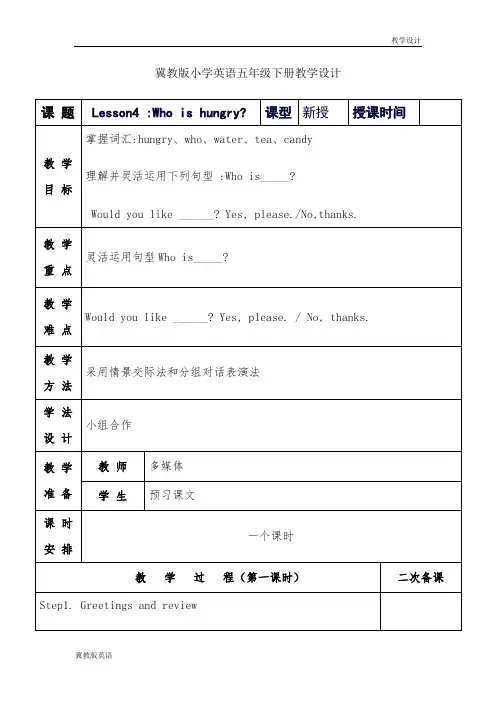
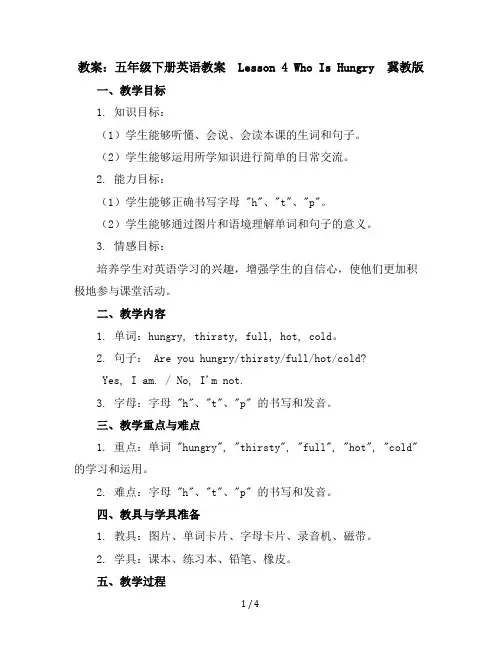
教案:五年级下册英语教案 Lesson 4 Who Is Hungry 冀教版一、教学目标1. 知识目标:(1)学生能够听懂、会说、会读本课的生词和句子。
(2)学生能够运用所学知识进行简单的日常交流。
2. 能力目标:(1)学生能够正确书写字母 "h"、"t"、"p"。
(2)学生能够通过图片和语境理解单词和句子的意义。
3. 情感目标:培养学生对英语学习的兴趣,增强学生的自信心,使他们更加积极地参与课堂活动。
二、教学内容1. 单词:hungry, thirsty, full, hot, cold。
2. 句子: Are you hungry/thirsty/full/hot/cold?Yes, I am. / No, I'm not.3. 字母:字母 "h"、"t"、"p" 的书写和发音。
三、教学重点与难点1. 重点:单词 "hungry", "thirsty", "full", "hot", "cold" 的学习和运用。
2. 难点:字母 "h"、"t"、"p" 的书写和发音。
四、教具与学具准备1. 教具:图片、单词卡片、字母卡片、录音机、磁带。
2. 学具:课本、练习本、铅笔、橡皮。
五、教学过程1. 热身(5分钟)教师与学生进行简单的英语对话,检查学生对之前所学知识的掌握情况。
2. 导入(10分钟)教师出示图片,引导学生说出 "hungry", "thirsty", "full", "hot", "cold",并板书这些单词。

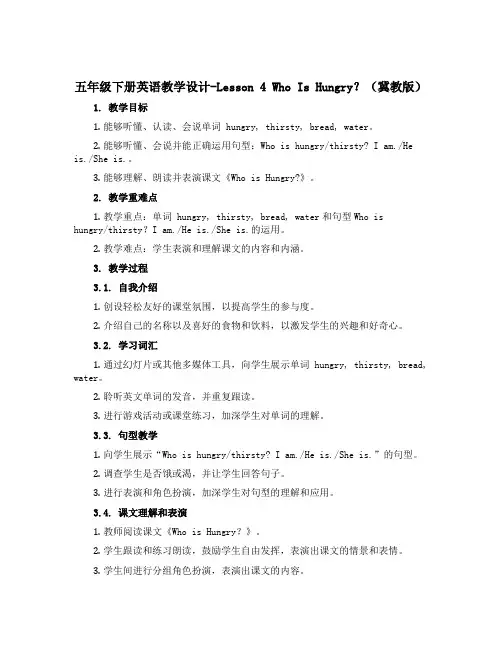
五年级下册英语教学设计-Lesson 4 Who Is Hungry?(冀教版)1. 教学目标1.能够听懂、认读、会说单词 hungry, thirsty, bread, water。
2.能够听懂、会说并能正确运用句型:Who is hungry/thirsty? I am./He is./She is.。
3.能够理解、朗读并表演课文《Who is Hungry?》。
2. 教学重难点1.教学重点:单词 hungry, thirsty, bread, water和句型Who ishungry/thirsty?I am./He is./She is.的运用。
2.教学难点:学生表演和理解课文的内容和内涵。
3. 教学过程3.1. 自我介绍1.创设轻松友好的课堂氛围,以提高学生的参与度。
2.介绍自己的名称以及喜好的食物和饮料,以激发学生的兴趣和好奇心。
3.2. 学习词汇1.通过幻灯片或其他多媒体工具,向学生展示单词 hungry, thirsty, bread, water。
2.聆听英文单词的发音,并重复跟读。
3.进行游戏活动或课堂练习,加深学生对单词的理解。
3.3. 句型教学1.向学生展示“Who is hungry/thirsty? I am./He is./She is.”的句型。
2.调查学生是否饿或渴,并让学生回答句子。
3.进行表演和角色扮演,加深学生对句型的理解和应用。
3.4. 课文理解和表演1.教师阅读课文《Who is Hungry?》。
2.学生跟读和练习朗读,鼓励学生自由发挥,表演出课文的情景和表情。
3.学生间进行分组角色扮演,表演出课文的内容。
4. 课堂练习1.对学生进行个人测试,测试学生对单词和句型的掌握情况。
2.进行小组讨论,让学生用所学内容描述自己的饮食习惯和喜爱。
5. 作业布置1.完成课堂练习的词汇练习和句型练习。
2.完成作文,谈谈自己最喜欢的饮食和饮料。
6. 教学反思该课程主要是针对五年级学生的英语掌握能力进行设计的。
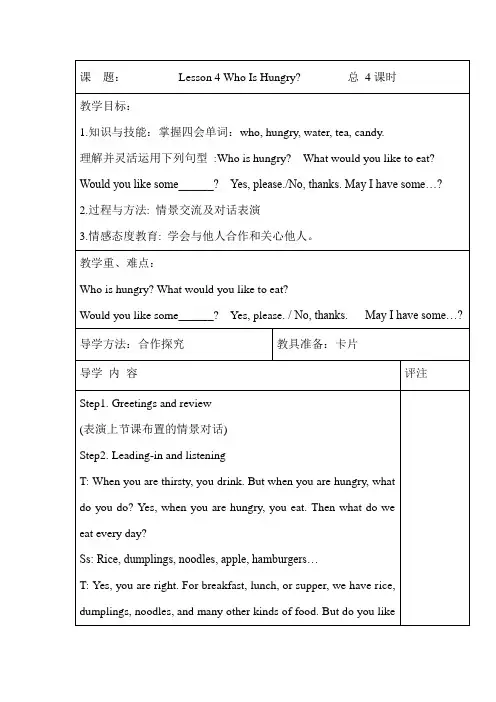
第二课时教学目标:1. 能听懂、会说、认读并拼写下列词汇:zoo, panda, monkey, elephant, big, small.2.能听懂、会说并开口运用下列用语和句子:The elephant is big.The bird is small.The panda is fat.The monkey is thin.3.教学重、难点zoo, panda, monkey, elephantbig, small, fat, thin教学过程:一、Greeting二、新授1、幻灯片提出问题:图片中的是什么地方?同学们有没有去过动物园?出示新单词zoo,讲解并领读单词。
复习句型:What’s this?It’s a _____.利用幻灯片播放学习新单词:panda, monkey, elephant。
教师领读单词。
2、猜谜语:教师用动作引导学生学习新单词,加深记忆。
3、观察图片,根据图片内容学习句型:The elephant is big.The bird is small.The panda is fat.The monkey is thin.在黑板上书写句子,学生进行句型练习。
4.出示幻灯片big/small, fat/thin,顺便说出他们是反义词。
5.练习:学生运用所学词汇进行句型练习,并完成课本第三部分:Le t’s do it!。
6.教师领读句子。
7.Homework:认读并拼写新单词。
8.板书设计:Lesson 7 At the zoozoo panda monkey elephant big small The elephant is big.The bird is small.The panda is fat.The monkey is thin.。
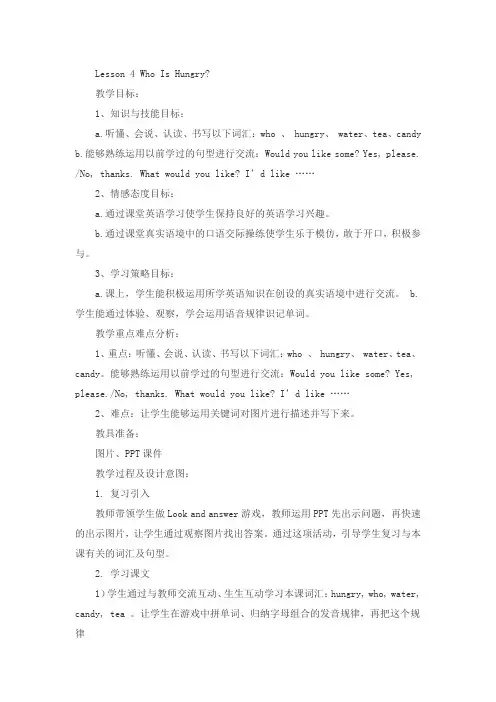
Lesson 4 Who Is Hungry?教学目标:1、知识与技能目标:a.听懂、会说、认读、书写以下词汇:who 、 hungry、 water、tea、candyb.能够熟练运用以前学过的句型进行交流:Would you like some? Yes, please. /No, thanks. What would you like? I’d like ……2、情感态度目标:a.通过课堂英语学习使学生保持良好的英语学习兴趣。
b.通过课堂真实语境中的口语交际操练使学生乐于模仿,敢于开口,积极参与。
3、学习策略目标:a.课上,学生能积极运用所学英语知识在创设的真实语境中进行交流。
b.学生能通过体验、观察,学会运用语音规律识记单词。
教学重点难点分析:1、重点:听懂、会说、认读、书写以下词汇:who 、 hungry、 water、tea、candy。
能够熟练运用以前学过的句型进行交流:Would you like some? Yes, please./No, thanks. What would you like? I’d like ……2、难点:让学生能够运用关键词对图片进行描述并写下来。
教具准备:图片、PPT课件教学过程及设计意图:1. 复习引入教师带领学生做Look and answer游戏,教师运用PPT先出示问题,再快速的出示图片,让学生通过观察图片找出答案。
通过这项活动,引导学生复习与本课有关的词汇及句型。
2. 学习课文1)学生通过与教师交流互动、生生互动学习本课词汇:hungry, who, water, candy, tea 。
让学生在游戏中拼单词、归纳字母组合的发音规律,再把这个规律运用到实际当中去,从而实现发音规律为学习单词服务的目的,培养学生良好的语音学习习惯。
2)学生听课文,初步整体感知文本信息,边听边做(图一)。
培养学生听音、整体理解文本的学习策略。
图一听力结束后,学生对文本有了大概的了解后,让学生独立阅读课文,完成(图二)。
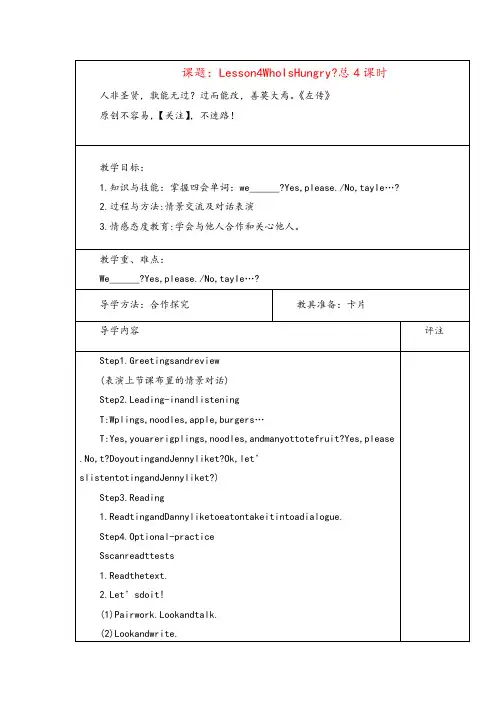
【素材积累】
每个人对未来都有所希望和计划,立志是成功的起点,有了壮志和不懈的努力,就能向成功迈进。
1、立志多在少年,但宋朝文学家苏洵27岁开始发愤,立志就读,昼夜不息,结果大器晚成,终于成为唐宋八大家之一。
2、我国明代画家王冕,少年放牛时,立志要把荷花佳景惟妙惟肖地画出来。
他不分昼夜地绘画,立志不移,后来成为当时著名的画家。
3、越王勾践被吴国军队打败,忍受奇耻大辱,给吴王夫差当奴。
三年后,他被释放回国,立志洗雪国耻。
他卧薪尝胆,发愤图强,终于打败了吴国。
4、有志者事竟成,百二秦关终归楚;苦心人天不负,三千越甲可吞吴。
——蒲松龄。
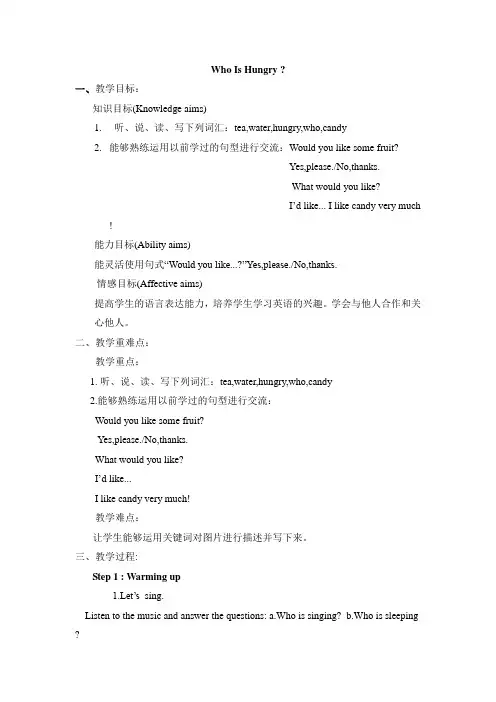
Who Is Hungry ?一、教学目标:知识目标(Knowledge aims)1.听、说、读、写下列词汇:tea,water,hungry,who,candy2.能够熟练运用以前学过的句型进行交流:Would you like some fruit?Yes,please./No,thanks.What would you like?I’d like... I like candy very much !能力目标(Ability aims)能灵活使用句式“Would you like...?”Yes,please./No,thanks.情感目标(Affective aims)提高学生的语言表达能力,培养学生学习英语的兴趣。
学会与他人合作和关心他人。
二、教学重难点:教学重点:1. 听、说、读、写下列词汇:tea,water,hungry,who,candy2.能够熟练运用以前学过的句型进行交流:Would you like some fruit?Yes,please./No,thanks.What would you like?I’d like...I like candy very much!教学难点:让学生能够运用关键词对图片进行描述并写下来。
三、教学过程:Step 1 : Warming up1.Let’s sing.Listen to the music and answer the questions: a.Who is singing? b.Who is sleeping ?2. Review and leading:Let’s a game,Look and answer.Note: A.The picture goes very fast.Please look carefully!B.If you find the answer. Please put up your hand.3.Show pictures and questions:a.Who is crying?b.Who is running?c.Who is drinking?d.Who is eating?4.Leading-in:I’m eating. So I’m hungry.Today we will learn lesson4:Who Is Hungry?Step 2 : Presentation1.I want something to eat.Now group,Here are so many foods.T:Do you know,What are they?S: T:I’d like some bread. What would you like?S: 2.There are some fruit. T:What fruit can you see?S: T:They are fruit. Would you like some fruit?( Write the answer on the blackboard: Yes,please./No,thanks.)3.I’m not thirty and I’m not hungry.But ,I want something to eat.Guess it, It’s sweet! It’s yummy! But don’t eat tooStep 3:Practice1.Listen and follow to read.2.Read the text and answer the questions.3.Try to make it into a dialogue.Step 4:Production1.Let’s do it.2.Pair work,Look and talk.3.Look and write. 。
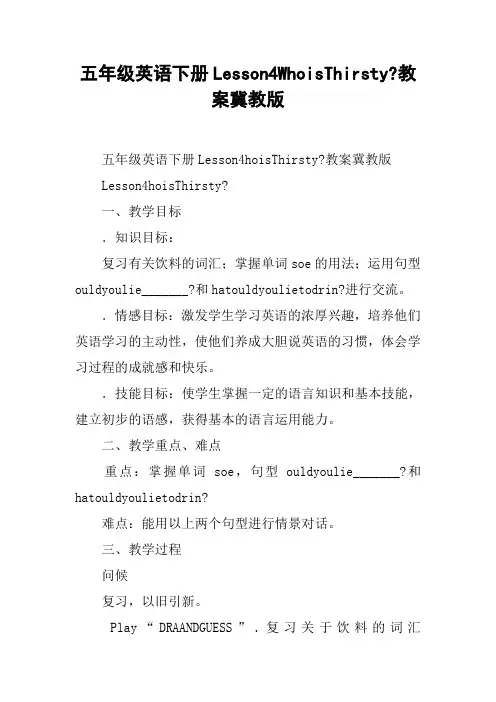
五年级英语下册Lesson4WhoisThirsty?教案冀教版五年级英语下册Lesson4hoisThirsty?教案冀教版Lesson4hoisThirsty?一、教学目标.知识目标:复习有关饮料的词汇;掌握单词soe的用法;运用句型ouldyoulie_______?和hatouldyoulietodrin?进行交流。
.情感目标:激发学生学习英语的浓厚兴趣,培养他们英语学习的主动性,使他们养成大胆说英语的习惯,体会学习过程的成就感和快乐。
.技能目标:使学生掌握一定的语言知识和基本技能,建立初步的语感,获得基本的语言运用能力。
二、教学重点、难点重点:掌握单词soe,句型ouldyoulie_______?和hatouldyoulietodrin?难点:能用以上两个句型进行情景对话。
三、教学过程问候复习,以旧引新。
Play“DRAANDGUESS”.复习关于饮料的词汇popilteajuice。
指名抓纸条,在黑板上画图,其它同学猜。
拓展词汇:coffee、cocacola等。
新授,师生互动:T:Iataling.Iathirsty.Areyouthirsty?T:Iouldliesoeater.ayIhavesoeater?请一名拿ater卡片的学生到前面T:ehere,please.从e引出soe,帮助学生识记soe的读音。
理解soe的意思。
Soe即可以接不可数名词,又可接可数名词复数。
告诉学生形容饮料的单词没有“一个”的说法,只能说一些,或者一瓶,一杯等等。
手拿准备好的饮料,让学生练习用soe或acupof,abottleof,aglassof修饰这些单词。
并提醒学生注意acupof,abottleof,aglassof这些词修饰的是什么词,它们都是固定搭配。
或用卡片练习soeater/pop/il/tea,看谁说出的饮料种类多。
T:Iouldliesoeater.ouldyouliesoeater?S:yes,please./No,thanyou.T:hatouldyoulietodrin?S:Iouldliesoe____.采用师生对话的形式,和学生多练习。
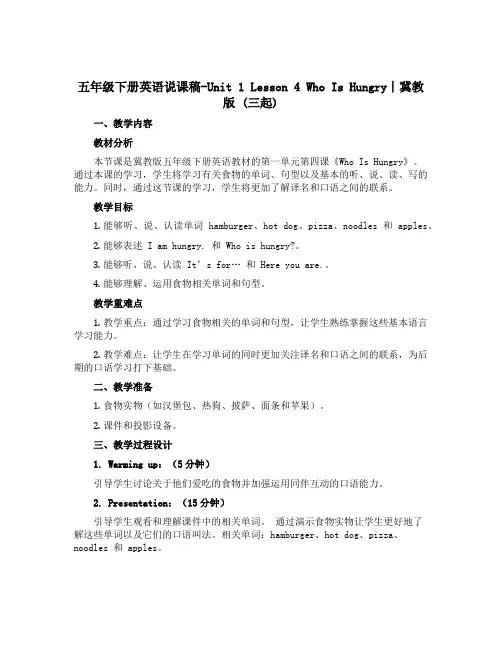
五年级下册英语说课稿-Unit 1 Lesson 4 Who Is Hungry∣冀教版 (三起)一、教学内容教材分析本节课是冀教版五年级下册英语教材的第一单元第四课《Who Is Hungry》。
通过本课的学习,学生将学习有关食物的单词、句型以及基本的听、说、读、写的能力。
同时,通过这节课的学习,学生将更加了解译名和口语之间的联系。
教学目标1.能够听、说、认读单词 hamburger、hot dog、pizza、noodles 和 apples。
2.能够表述 I am hungry. 和 Who is hungry?。
3.能够听、说、认读It’s for… 和 Here you are.。
4.能够理解、运用食物相关单词和句型。
教学重难点1.教学重点:通过学习食物相关的单词和句型,让学生熟练掌握这些基本语言学习能力。
2.教学难点:让学生在学习单词的同时更加关注译名和口语之间的联系,为后期的口语学习打下基础。
二、教学准备1.食物实物(如汉堡包、热狗、披萨、面条和苹果)。
2.课件和投影设备。
三、教学过程设计1. Warming up:(5分钟)引导学生讨论关于他们爱吃的食物并加强运用同伴互动的口语能力。
2. Presentation:(15分钟)引导学生观看和理解课件中的相关单词。
通过演示食物实物让学生更好地了解这些单词以及它们的口语叫法。
相关单词:hamburger、hot dog、pizza、noodles 和 apples。
3. Practice1:(15分钟)让学生进行口语练习:“I am hungry”,“Who is hungry?” 等基本句型,并引导学生针对这些基本句型进行小组活动。
4. Practice2:(10分钟)通过课件呈现更多的句子,如It’s for… 和 Here you are. 并要求学生理解和运用这些句型。
5. Extension:(10分钟)引导学生观看和学习相关视频,并通过视频了解食物、口音和词语之间的关联。
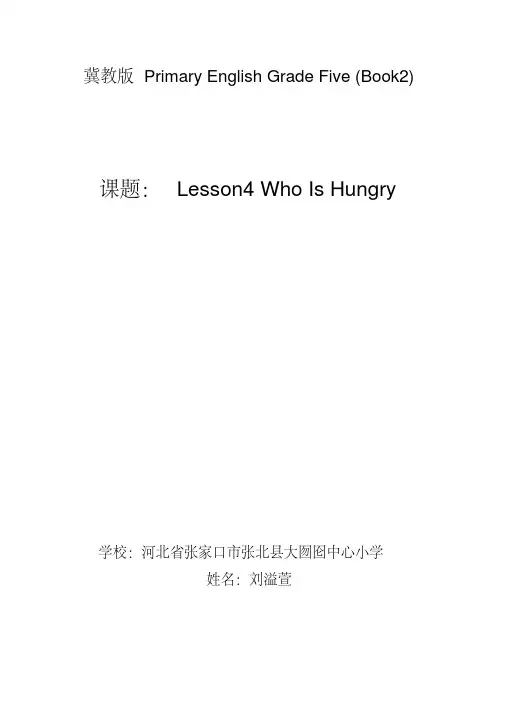
五年级下册英语教案-Lesson 4 Who Is Hungry?教学目标1.学生能够听懂、说出并熟练运用单词 hungry、thirsty、hot、cold、tired、angry。
2.学生能够听懂、理解并会说句型“Who is hungry?I’m hungry.”3.学生能够通过如何询问别人饥饿程度,并为别人提供帮助,发挥合作精神。
4.学生能够在日常生活中运用所学单词和句型,表达自己的需求与感受。
教学重点1.学生能够听懂、说出并熟练运用单词 hungry、thirsty、hot、cold、tired、angry。
2.学生能够听懂、理解并会说句型“Who is hungry?I’m hungry.”教学难点1.学生能够通过如何询问别人饥饿程度,并为别人提供帮助,发挥合作精神。
教学准备1.播放器。
2.PPT课件。
3.卡片。
教学过程Step 1 Warming-up1.教师播放相关视频,呈现学习主题,激发学生学习英语的兴趣。
2.教师与学生进行自我介绍,呈现学生课前自学情况。
3.通过呈现对话,帮助学生理解会运用到的单词和句型。
Step 2 Pre-task1.教师呈现相关视频,让学生思考饥饿的感想与感受。
2.教师播放相关单词视频,并教授学生新单词:hungry、thirsty、hot、cold、tired、angry。
3.教师呈现与单词相关的图片,并让学生自由组合表达。
Step 3 Task1.教师呈现相关视频或卡片,介绍学习单词-句型“ Who is hungry?I’m hungry.”2.教师模拟对话,并让学生进行模仿。
3.学生自由组合对话,并且和同桌进行表演。
Step 4 Production1.让学生自由创作一篇短文,描述自己的感受和需求,运用学过的单词和句型。
2.让学生自由展示,教师及同学进行评价、点评和纠正。
Step 5 Homework1.学生完成相关练习。
2.学生预习下一个单元。
Lesson4 Who Is Hungry?教案一、教学目标:1、学生能听懂、会说、认读并书写下列词汇:who, hungry, water, tea, candy2、学生能认读,理解并运用下列基本句型结构:Who is hungry?Would you like _______? Yes, please. / No, thanks.二、教学重点:1、学生能听懂、会说、认读并书写下列词汇:who, hungry, water, tea, candy2、学生能认读,理解并运用下列基本句型结构:Who is hungry?Would you like _______? Yes, please. / No, thanks.三、教学难点:能运用下列句型结构进行对话:Who is hungry?Would you like _______? Yes, please. / No, thanks.四、教学用具:多媒体,单词卡五、教学步骤和建议(一)课前导入1.教师出示PPT3,通过图片展示一个人饥饿,并提出问题Are you hungry?引出本节课话题。
2.让学生打开课本第8页,观察图片并讨论图片内容(二)重点呈现1.出示PPT4,展示本节课重点词汇和句型2.PPT5-PPT9学习本课的重点词汇(1)教师通过展示图片,引导学生学习重点单词(2)通过单词卡片对单词进行操练,帮助学生会读每个单词,理解其含义,并会拼写、造句(3)学习新单词的同时,复习上节课讲的主系表结构3.PPT10-PPT12学习本课的重点句型(1)PPT11句型:Who is hungry?帮助学生理解单词who,讲解其用法,用来询问人的身份或姓名,构成特殊疑问句(2)PPT12-14句型:Would you like…?讲解句型的用法及注意事项。
如:like后可接可数名词,也可接不可数名词;肯定回答及否定回答(3)PPT16-17易错答疑,Would you like…?句型中some的特殊用法4.老师读课文,学生跟读5.分角色朗读课文6.角色扮演,表演对话7.教师出示PPT158-19,课本第9页,第一部分Pair work. Look and talk.(1)让学生观察图片,并朗读例句(2)两人一组,练习句型(3)句型展示,老师及时给予正确评价8.教师出示PPT20-22课本第9页,第二部分Look and write.(1)学生观察图片和所给单词,朗读并分组讨论图片表达的意思(2)说出图片中每个人物及每个人物的动作,并用英语准确表达出来(3)参考所给出的例子,完成句子(4)成果展示,老师及时给予正确评价(三)课外拓展教师出示PPT23What would you like when you're thirsty?你口渴时,想喝什么?由本课的thirsty引发相关的饮品总结与复习(四)当堂练习教师出示PPT24-25,1.用所给词的正确形式填空2.把答语和问题相匹配。
冀教版英语五下Lesson4《Whoishungry》word导学案Grade:Group:Name:Designer: Jing Lu You are the best! ( 你是最棒的!)【学习目标】1、重点词汇:有关食物名词2、明白得并把握句型:1) Who is hungry? 2) Would you like some______? Yes, please./No, thanks.【学习重难点】明白得并把握句型:1) Who is hungry? 2) Would you like some______? Yes, please./No, thanks.【学法指导】引导学生逐步把握自主学习、合作探究的学习模式。
【课前预备】录音机【学习流程】I.Class OpeningT: I am hungry, I would like some dumplings. Would you like some dumplings?Ss:______________.II.展现交流1.(看看你的预习成果)写出下列单词:糖果__________ 渴的__________ 饥饿的__________ 水_____________茶___________ 谁___________ 橘子_____________苹果___________2、小组内组长组织读课文,分角色朗读表演对话.III:反馈拓展1.依照中文提示,回答问题。
1)Would you like some noodles ?(作确信回答)___________________________________________________________ ______2)What are you doing ?(以“看电视”回答)___________________________________________________________ ______2.连词成句。
五年级下英语教案-Lesson 4 Who Is Hungry-冀教版教学内容本节课的教学内容为Lesson 4 Who Is Hungry。
课文内容:A: Who is hungry?B: I’m hungry.A: What do you want to eat?B: I want some bread.A: Here you are.B: Thank you.教学目标1.学生能够听懂、会说句型“Who is hungry?”,“I’m hungry.”,“What do you want to eat?”,“I want some bread.”和“Thank you.”2.学生能够学会用英文对话表达自己想要吃的东西。
教学重难点1.教学重点:单词和表达方式的学习,如hungry, bread等。
2.教学难点:如何促进学生口语表达能力的提高。
教学准备1.PPT课件2.教师准备面包3.一些DVD或视频辅助教学教学过程导入新课教师出示一张照片或视频,向学生介绍食物并鼓励他们阐述食物所在的场景。
然后在教学课文之前,提出“Who is hungry?”这句话,并向学生发问,问他们意识到了什么,有多少人感到饥饿,然后解释课文是关于如何表达饥饿的。
明确文本内容和语言目标教师阐述课文中的一些重要单词,如“hungry”和“bread”,并向学生介绍一些新的词汇。
然后模拟对话,在学生中让他们模仿和反复练习该对话。
练习和运用语言1.学生自我介绍,表达自己感到饥饿并想吃些什么。
2.学生分组进行角色扮演练习。
3.学生进入游戏环节,并模拟餐厅场景进行口头表达。
讲解文化知识通过DVD或其他视频辅助教学,讲解中西方文化的不同之处,比如中西方餐桌礼仪、饮食文化等。
课堂总结在回顾今天的课程时,教师会总结和提醒学生今天所学的东西,并再次鼓励他们加强训练,提高他们英文口语表达水平。
作业评估学生,检查他们的英语口语水平。
为加强学生的英语口语表达能力,教师可以布置一些与“饥饿”相关的话题,让学生用英文谈一谈。
Unit 1师者,所以传道,授业,解惑也。
韩愈东进学校陈思思Lesson4 Who Is HungryWho is hungry? Would you like ______? Yes, please./No, thanks.K]【知识目标】1. 学生能听懂、会说、认读并书写下列词汇:who,hungry, water, tea, candy 2. 学生能认读、理解并运用下列基本句型结构:Who is hungry?Would you like ______?Yes, please./No, thanks.【能力目标】通过本节课的学习,使学生会表述别人是否喜欢某物。
【情感目标】增进学生彼此交流的机会。
【教学重点】—Would you like …?—Yes, please./No, thanks.【教学难点】—Would you like …?—Yes, please./No, thanks.Tape recorder, Multimedia◆教学过程Step 1. Warm-up1. greetings(1) when the student walks into the classroom, it plays the new song that was learned yesterday. Say hello to the students in English and welcome them to the classroom. Review the new words you have learned yesterday.(2) let everyone stand up. Start from a student to allow him / her to read the first line of the song. Continue to let the next student read the next line until the whole song is read Students help them when they have difficulties in reading aloud. Thank you for the students' attempt. (3) now, all the people sing the song together.Step 2. Presentation1. Who is hungry?(1) use vocabulary cards to teach words: tea, water, hungry who, candy. Raise the card and explain the meaning of the word in Chinese. Let the students read the words read. Learn every new word in the same way. Write down the words on the blackboard. Do nt forget to do some exaggerated movements or facial expresions to describe the meaning of the word. For example, when Professor hungry is taught, the teacher can hold down the stomach and oan; and wen Professor water is taught, the teacher can pretend to drink water.(2) let the students turn to page eighth. Play the first part of the recording, students reading and playingtwo times or times, walking around, listening to the s tudents' pronunciation. Help when necessary.2. demoDiscuss what the students have just heard. Let a brave man stand up and retell the content that is heard in the recording. Teachers can ask questions such as: Who is hungry? Who is thirsty? Is Jenny hungry orthirsty? What.3. practiceLet the two men come to the front of the brave. The teacher asked: "Who is hungry? A student answer: I asked: Would am hungry. you like some ______? The volunteer students can answer Yes, please or No, thanks. second go getters: Would you like some then asked D ______? The answer may be “Yes or No”.Cos-playDivide the whole class into a group of four. Each group prepares a brief presentation based on the first part of the textbook.The first group - the story of the demonstration and the book.The second group - a demonstration of the same story, but Li Ming and Jenny were all hungry this time. Imagine what they want to eat.The third group - a demonstration of the story, but this time Danny was not hungry.The fourth group - a demonstration of the story, but this time everyone was hungry. They were sitting on the train and eating.Step 3.PracticeLet 's do it!Let the students turn to page ninth and see the second part.1. Pair work. Look and talk.Explain how to do this activity. Let the students look at the picture of the food, and then a student asks Would you like some? Another student answers Yes, please./ No, thanks.2. Look and write.Look at the second activities of the ninth page. Explain what the students have to do. Let the students observe the picture on the left side of the page, judge what the person is doing in the picture, and then find out the correct words that can describe the picture from the right word list.Take the first picture as an example. The baby is tired. What is he doing? He was sleeping。